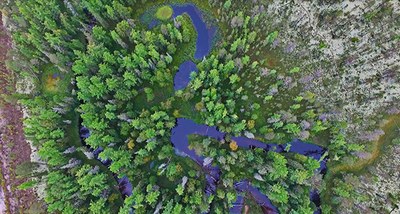Greenhouse emissions from Siberian rivers peak as permafrost thaws

Western Siberia forest patch in a permafrost landscape.
Photo: Svetlana Serikova, Umeå University
Permafrost soils store large quantities of frozen carbon and play an important role in regulating Earth’s climate In a study published in Nature Geoscience, researchers from the Humboldt-Universität zu Berlin, in collaboration with an international team, now show that river greenhouse gas emissions are highest in areas where Siberian permafrost is actively thawing.
As permafrost degrades, previously frozen carbon can end up in streams and rivers where it will be processed and emitted as greenhouse gases from the water surface directly into the atmosphere. Quantifying these river greenhouse gas emissions is particularly important in Western Siberia – an area that stores vast amounts of permafrost carbon and is a home to the Arctic’s largest watershed drained by the Ob’ River.
Now researchers from IGB Leibniz Institute of Freshwater Ecology and Inland Fisheries (with collaborators from Sweden, Russia, France and the UK) have shown that river greenhouse gas emissions peak in the areas where Western Siberian permafrost has been actively degrading and decrease in areas where climate is colder, and permafrost has not started to thaw yet. The research team has also found out that greenhouse gas emissions from rivers exceed the amount of carbon that rivers transport directly to the Arctic Ocean.
“This finding was unexpected as it means that rivers in Western Siberia actively process and release much of the carbon they receive from waters melting in degrading permafrost and that the size of these emissions might increase as climate continues to warm” says Professor Doerthe Tetzlaff, Department of Geography at Humboldt-Universität and Head of Ecohydrology at IGB, and one of the researchers in the team.
Quantifying river greenhouse gas emissions from permafrost-affected areas in general and in Western Siberia in particular is important as it improves our understanding the role such areas play in the global carbon cycle as well as increases our abilities of predicting the impacts of a changing climate on the Arctic.
“The large-scale changes that take place in the Arctic due to warming exert a strong influence on the climate system and have far-reaching consequences for the rest of the world. That is why it is important we focus on capturing how climate warming affects the Arctic now before these dramatic changes happen” says Svetlana Serikova, the lead author of the paper and doctoral student at Umeå University.
Publication
S. Serikova, O.S. Pokrovsky, P. Ala-Aho, V. Kazantsev, S.N. Kirpotin, S.G. Kopysov, I.V. Krickov, H. Laudon, R.M.Manasypov, L.S. Shirokova, C. Soulsby, D. Tetzlaff and J. Karlsson, High riverine CO2 emissions at the permafrost boundary of Western Siberia, Nature Geoscience,
DOI 10.1038/s41561-018-0218-1.
Link to Study: High riverine CO2 emissions at the permafrost boundary of Western Siberia
Contact
Prof. Doerthe Tetzlaff
Department of Geography
Humboldt-Universität zu Berlin
